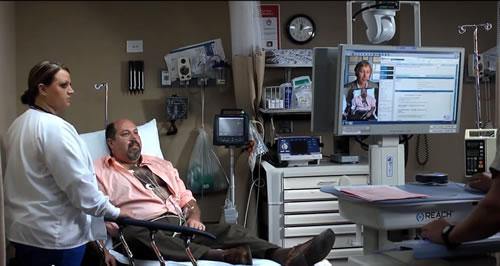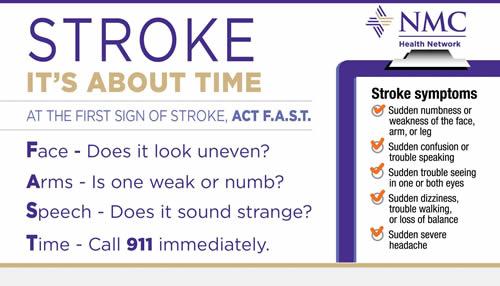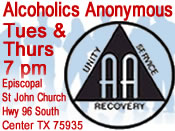
June 6, 2017 Nacogdoches – Every 40 seconds someone in the United States experiences a stroke; as the fifth leading cause of death and the #1 cause of preventable disability in the United States, prompt treatment of a stroke is paramount in order to prevent brain damage, lifelong disability, or even death. With another decision that displays NMC Health Network’s strong commitment to provide high quality healthcare solutions and superior service to Deep East Texans, the organization has announced that it is in active pursuit of The Joint Commission's Primary Stroke Center Certification. The advanced certification recognizes hospital systems that follow evidence based treatment guidelines for stroke care and provides an objective assessment of clinical excellence.
 Under the leadership of medical directors Dr. Joseph Scamardo and Dr. Blaise FerraraccioF, NMC’s multidisciplinary stroke team utilizes effective data-driven performance improvement processes as well as innovative treatment options in order to eliminate or reduce the devastating effects of stroke and lessen the chance of permanent disability. In addition to NMC’s neurologists, Teleneurology services are available to NMC emergency staff in both Nacogdoches and Shelby County via computerized video equipment. This exciting technology provides rapid consultations with neurological specialists from across the United States. Cameras are positioned so the doctor can clearly see and interact with patients, nurses and other physicians to provide evidence-based, protocol-driven care 24 hours per day/365 days a year.
Under the leadership of medical directors Dr. Joseph Scamardo and Dr. Blaise FerraraccioF, NMC’s multidisciplinary stroke team utilizes effective data-driven performance improvement processes as well as innovative treatment options in order to eliminate or reduce the devastating effects of stroke and lessen the chance of permanent disability. In addition to NMC’s neurologists, Teleneurology services are available to NMC emergency staff in both Nacogdoches and Shelby County via computerized video equipment. This exciting technology provides rapid consultations with neurological specialists from across the United States. Cameras are positioned so the doctor can clearly see and interact with patients, nurses and other physicians to provide evidence-based, protocol-driven care 24 hours per day/365 days a year.
“Research shows that early treatment and a quick response can mean the difference between recovery and disability.” said NMC’s Director of Emergency Services, Christina Westgate, RN, BSN, MPA, CEN. “We have a saying in the Emergency Department – ‘Time is brain.’ That means in a stroke, every single second can mean the loss of more brain cells, leading to brain damage that will cause permanent physical disability. So, even shaving off a minute can mean less damage to the brain and less devastation to a patient’s life.”
Another important aspect of guideline-based care includes the aggressive use of medications, such as the clot-busting drug TPA (tissue plasminogen activator). The FDA-approved drug can save lives and reduce the long-term effects of stroke when promptly administered within the first hours of a stroke. It is important to remember that this drug can only be used within three hours of the onset of symptoms, making it extremely important to note the time that the first signs of stroke occurred. For this treatment to be considered, there must be enough time to determine — through an imaging test like a CT scan or an MRI — whether the stroke is ischemic (caused by a clot), or hemorrhagic (caused by a bleed). Often TPA is not administered because patients do not get to the hospital within this crucial three-hour treatment window. This is yet another reason to immediately get your loved one to the hospital as quickly as possible when stroke symptoms are initially observed.
“A stroke won’t wait and neither should you.” said NMC Shelby County Emergency Department Director, Tammy Hanson, RN. “Recognizing the signs of a stroke and getting to an emergency room are the first steps in receiving life-saving treatment. Our goal is to administer clot-busting medications like TPA within 60 minutes of the onset of your symptoms.”
Efforts to meet the requirements for Primary Stroke Center Certification strengthens the culture of excellence set forth by NMC’s Mission: to serve, heal and educate the community. “We are committed to improving the health of the communities where we live and serve,” said NMC CEO Jeff Patterson. “It is our goal to provide the best, most reliable care to our patients, and to be the healthcare provider of first choice based on quality, value and range of services.”
Recognizing Stroke Symptons:
- It is important to both learn the signs and symptoms of stroke and act F.A.S.T. to identify symptoms of a stroke.
- FACE: Ask the person to smile. Does one side of the face droop?
- ARMS: Ask the person to raise both arms. Does one arm drift downward?
- SPEECH: Ask the person to repeat a simple sentence. Are the words slurred? Can he/she repeat the sentence correctly?
- TIME: If the person shows any of these symptoms, call 911 or get to the hospital fast. Every second counts because brain cells could be dying.
- Not every warning sign will occur in every stroke. And even if they do go away, these warning signs should not be ignored. Call 911 or quickly take the person to Nacogdoches Medical Center for stroke care. When talking to 911, an emergency medical service or the hospital, be sure to use the word “stroke.” Every minute counts when treating a stroke, thereby raising the number of brain cells that can be saved and chances for recovery.










